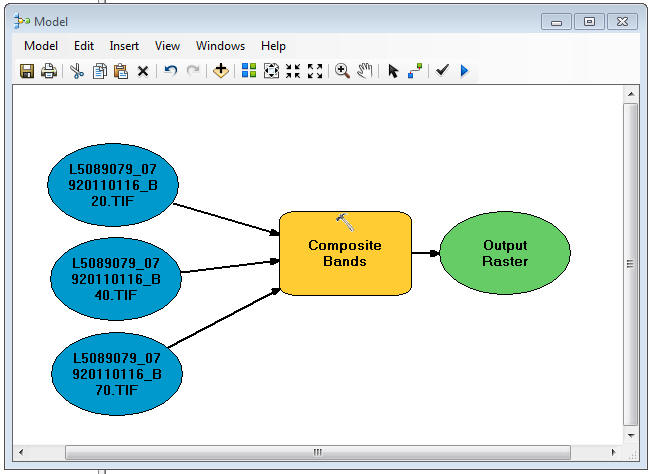
- #MODEL BUILDER SPATIAL ANALYST FAILS ON PYTHON EXPORT HOW TO#
- #MODEL BUILDER SPATIAL ANALYST FAILS ON PYTHON EXPORT CODE#
The Flow Accumulation tool calculates the accumulated flow to each cell, as determined by the accumulated weight of all cells that flow into each downslope cell. Verify the path name for Output accumulation raster.Use the output raster from Step 2 for Input flow direction raster.In ArcCatalog, navigate to Toolboxes > System Toolboxes > Spatial Analyst Tools > Hydrology > Flow Accumulation.The Flow Direction tool determines the direction of flow from each cell to its steepest downslope neighbor. Verify the path name for Output flow direction raster.Use the DEM output from Step 1 for Input surface raster.In ArcCatalog, navigate to Toolboxes > System Toolboxes > Spatial Analyst Tools > Hydrology > Flow Direction.When a Z-limit is not specified in the Fill tool window, all sinks, regardless of depth, are filled. The Sink (Spatial Analyst) tool can be used to identify the sinks and their depths prior to using the Fill tool. It is recommended to state the Z-limit if the depths of the sinks are known. A Z-limit affects the result of the tool.

The Fill tool fills sinks to remove imperfections from the DEM.
Verify the path name for Output surface raster. Use a digital elevation model (DEM) for Input surface raster. In ArcCatalog, navigate to Toolboxes > System Toolboxes > Spatial Analyst Tools > Hydrology > Fill. The following instructions provide a workflow to create a watershed model using the Hydrology toolset from the Spatial Analyst toolbox and convert the model to watershed bounding polygons. This area can be delineated from a digital elevation model (DEM) using the Hydrology toolset from the Spatial Analyst toolbox. Library/Frameworks/amework/Versions/2.7/bin/python2.7 /Users/samueltin/Projects/bitbucket/share-card-ml/pickle_test.pyįile “/Users/samueltin/Projects/bitbucket/share-card-ml/pickle_test.py”, line 8, inįile “/Library/Frameworks/amework/Versions/2.7/lib/python2.7/pickle.py”, line 1376, in dumpįile “/Library/Frameworks/amework/Versions/2.7/lib/python2.7/pickle.py”, line 224, in dumpįile “/Library/Frameworks/amework/Versions/2.7/lib/python2.7/pickle.py”, line 331, in saveįile “/Library/Frameworks/amework/Versions/2.7/lib/python2.7/pickle.py”, line 425, in save_reduceįile “/Library/Frameworks/amework/Versions/2.7/lib/python2.7/pickle.py”, line 286, in saveį(self, obj) # Call unbound method with explicit selfįile “/Library/Frameworks/amework/Versions/2.7/lib/python2.7/pickle.py”, line 655, in save_dictįile “/Library/Frameworks/amework/Versions/2.7/lib/python2.7/pickle.py”, line 669, in _batch_setitemsįile “/Library/Frameworks/amework/Versions/2.7/lib/python2.7/pickle.py”, line 606, in save_listįile “/Library/Frameworks/amework/Versions/2.7/lib/python2.7/pickle.py”, line 621, in _batch_appendsįile “/Library/Frameworks/amework/Versions/2.7/lib/python2.7/pickle.How To: Create a watershed model using the Hydrology toolset SummaryĪ watershed is an upslope area that contributes water flow as concentrated drainage. 
Model = VGG16(weights=’imagenet’, include_top=False)
#MODEL BUILDER SPATIAL ANALYST FAILS ON PYTHON EXPORT HOW TO#
It will be highly appreciated if you can give me some direction on how to fix this error.įrom 16 import VGG16
#MODEL BUILDER SPATIAL ANALYST FAILS ON PYTHON EXPORT CODE#
Please find my simplified code below and error log below: I further narrowed down the problem and find that it is the VGG16 model failed to pickle. My model is using VGG16 and replace the top layer for my classification solution. Thank you very much for teaching us machine learning.

I am your big fan and read a lot of your blog and books.
The joblib API for efficiently serializing Python objects with NumPy arrays.ĭo you have any questions about saving and loading your model?Īsk your questions in the comments and I will do my best to answer them. The pickle API for serializing standard Python objects. You learned two techniques that you can use: In this post you discovered how to persist your machine learning algorithms in Python with scikit-learn. Take note of the version so that you can re-create the environment if for some reason you cannot reload your model on another machine or another platform at a later time. Often the algorithms used by machine learning algorithms to make predictions are a lot simpler than those used to learn the parameters can may be easy to implement in custom code that you have control over. You might like to manually output the parameters of your learned model so that you can use them directly in scikit-learn or another platform in the future. 
This is not limited to the version of NumPy and the version of scikit-learn. The version of all major libraries used in your machine learning project almost certainly need to be the same when deserializing a saved model. You almost certainly require the same major (and maybe minor) version of Python used to serialize the model when you later load it and deserialize it. This section lists some important considerations when finalizing your machine learning models.








 0 kommentar(er)
0 kommentar(er)
